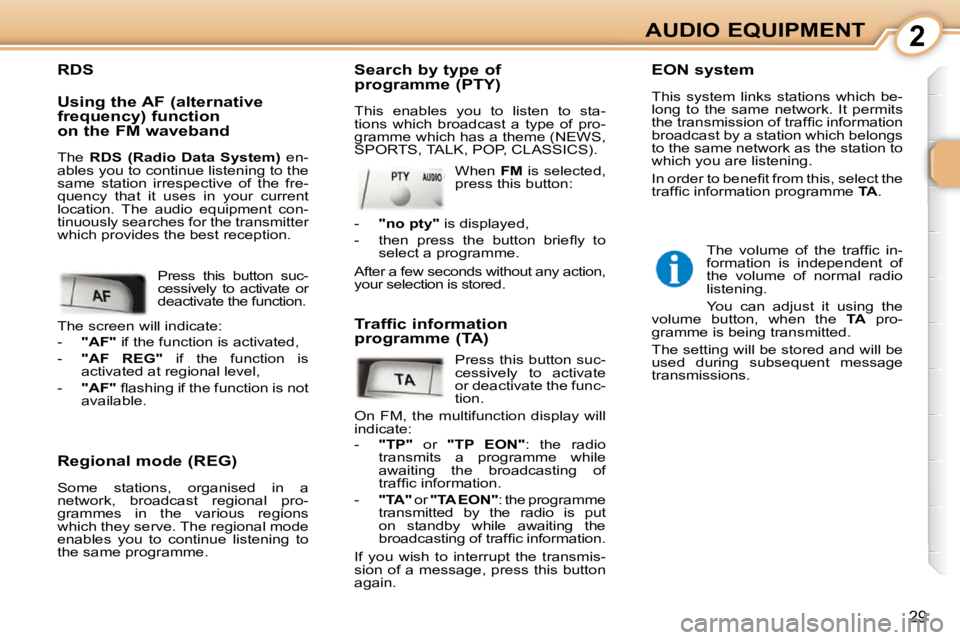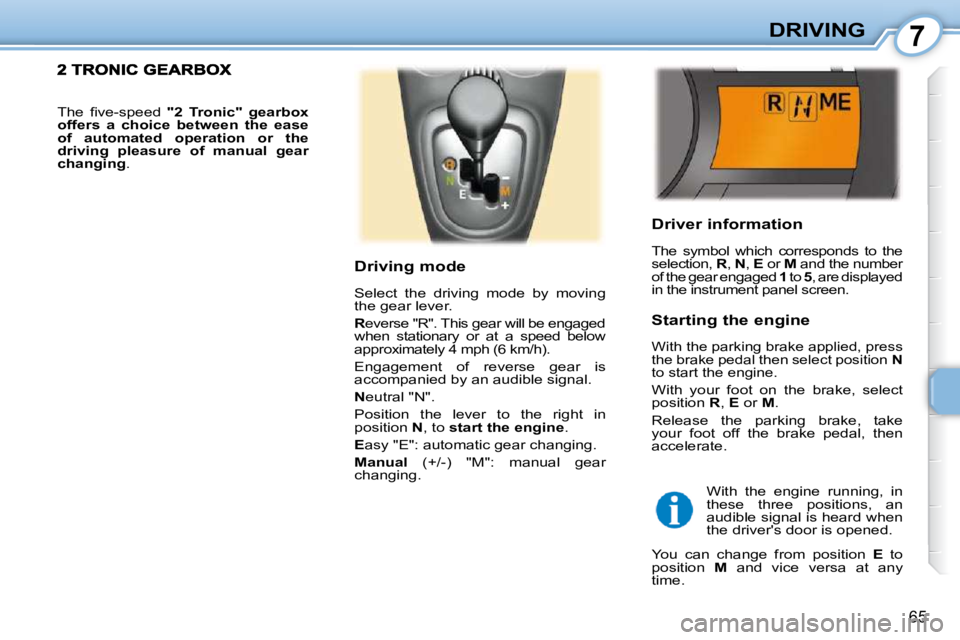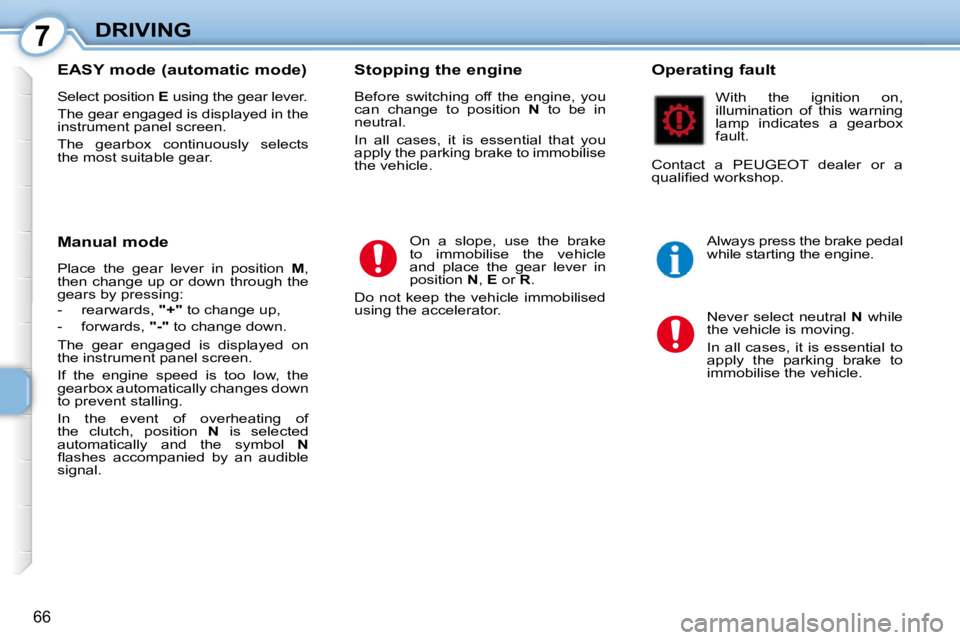Page 27 of 97

2
29
AUDIO EQUIPMENT
Regional mode (REG)
Some stations, organised in a
network, broadcast regional pro-
grammes in the various regions
which they serve. The regional mode
enables you to continue listening to
the same programme. Search by type of
programme (PTY)
This enables you to listen to sta-
tions which broadcast a type of pro-
gramme which has a theme (NEWS,
SPORTS, TALK, POP, CLASSICS).
EON system
This system links stations which be-
long to the same network. It permits
�t�h�e� �t�r�a�n�s�m�i�s�s�i�o�n� �o�f� �t�r�a�f�fi� �c� �i�n�f�o�r�m�a�t�i�o�n�
broadcast by a station which belongs
to the same network as the station to
which you are listening.
� �I�n� �o�r�d�e�r� �t�o� �b�e�n�e�fi� �t� �f�r�o�m� �t�h�i�s�,� �s�e�l�e�c�t� �t�h�e�
�t�r�a�f�fi� �c� �i�n�f�o�r�m�a�t�i�o�n� �p�r�o�g�r�a�m�m�e� �
TA .
Using the AF (alternative
frequency) function
on the FM waveband
The
RDS (Radio Data System) en-
ables you to continue listening to the
same station irrespective of the fre-
quency that it uses in your current
location. The audio equipment con-
tinuously searches for the transmitter
which provides the best reception.
Press this button suc-
cessively to activate
or deactivate the func-
tion.
On FM, the multifunction display will
indicate:
- "TP" or "TP EON" : the radio
transmits a programme while
awaiting the broadcasting of
�t�r�a�f�fi� �c� �i�n�f�o�r�m�a�t�i�o�n�.�
- "TA" or "TA EON" : the programme
transmitted by the radio is put
on standby while awaiting the
�b�r�o�a�d�c�a�s�t�i�n�g� �o�f� �t�r�a�f�fi� �c� �i�n�f�o�r�m�a�t�i�o�n�.� �
If you wish to interrupt the transmis-
sion of a message, press this button
again.
Traffic information
programme (TA)
Press this button suc-
cessively to activate or
deactivate the function.
The screen will indicate:
- "AF" if the function is activated,
- "AF REG" if the function is
activated at regional level,
- "AF" � � �fl� �a�s�h�i�n�g� �i�f� �t�h�e� �f�u�n�c�t�i�o�n� �i�s� �n�o�t�
available. When
FM is selected,
press this button:
� � �T�h�e� �v�o�l�u�m�e� �o�f� �t�h�e� �t�r�a�f�fi� �c� �i�n�-
formation is independent of
the volume of normal radio
listening.
You can adjust it using the
volume button, when the TA pro-
gramme is being transmitted.
The setting will be stored and will be
used during subsequent message
transmissions.
RDS
- "no pty" is displayed,
� � �-� � �t�h�e�n� �p�r�e�s�s� �t�h�e� �b�u�t�t�o�n� �b�r�i�e�fl� �y� �t�o� select a programme.
After a few seconds without any action,
your selection is stored.
Page 57 of 97
5
55
VISIBILITY
LIGHTING STALK
1. Lamps off
2. Sidelamps
3. Dipped headlamps/
Main beam
headlamps Dipped/Main beam headlamps
Dipped beam headlamps: pull the
stalk.
Main beam headlamps: push the
stalk.
Lighting on audible warning
When the driver's door is opened with
the ignition off, a continuous audible
signal is heard if you have left your
lighting on. Rear foglamp
With the dipped head-
lamps on, selection is
by rotation of ring B for-
wards to switch on and
rearwards to switch off.
The status is displayed by the indicator
lamp in the instrument panel.
In clear weather or in rain,
both day and night, the rear
foglamp is dazzling and its
use is prohibited.
Direction indicators (flashers)
Left: stalk downwards.
Right: stalk upwards.
Headlamp flash
Pull the stalk fully towards you.
Front and rear lamps
Selection is by rotation of ring
A .
Switching to sidelamps does
not switch off the rear foglamp
if it is on.
Do not forget to switch them off when
they are no longer needed.
Page 70 of 97

7
65
DRIVING
Driver information
The symbol which corresponds to the
selection, R , N , E or M and the number
of the gear engaged 1 to 5 , are displayed
in the instrument panel screen.
Driving mode
Select the driving mode by moving
the gear lever.
R everse "R". This gear will be engaged
when stationary or at a speed below
approximately 4 mph (6 km/h).
Engagement of reverse gear is
accompanied by an audible signal.
N eutral "N".
Position the lever to the right in
position N , to start the engine .
E asy "E": automatic gear changing.
M anual (+/-) "M": manual gear
changing. Starting the engine
With the parking brake applied, press
the brake pedal then select position
N
to start the engine.
With your foot on the brake, select
position R , E or M .
Release the parking brake, take
your foot off the brake pedal, then
accelerate.
With the engine running, in
these three positions, an
audible signal is heard when
the driver's door is opened.
� � �T�h�e� �fi� �v�e�-�s�p�e�e�d� �
"
2 Tronic" gearbox
offers a choice between the ease
of
automated operation or the
driving pleasure of
manual gear
changing .
You can change from position E to
position M and vice versa at any
time.
Page 71 of 97

7
66
DRIVING
EASY mode (automatic mode)
Select position E using the gear lever.
The gear engaged is displayed in the
instrument panel screen.
The gearbox continuously selects
the most suitable gear.
Manual mode
Place the gear lever in position M ,
then change up or down through the
gears by pressing:
- rearwards, "+" to change up,
- forwards, "-" to change down.
The gear engaged is displayed on
the instrument panel screen.
If the engine speed is too low, the
gearbox automatically changes down
to prevent stalling.
In the event of overheating of
the clutch, position N is selected
automatically and the symbol N
�fl� �a�s�h�e�s� �a�c�c�o�m�p�a�n�i�e�d� �b�y� �a�n� �a�u�d�i�b�l�e�
signal. Operating fault
Stopping the engine
Before switching off the engine, you
can change to position N to be in
neutral.
In all cases, it is essential that you
apply the parking brake to immobilise
the vehicle. With the ignition on,
illumination of this warning
lamp indicates a gearbox
fault.
On a slope, use the brake
to immobilise the vehicle
and place the gear lever in
position N , E or R .
Do not keep the vehicle immobilised
using the accelerator. Always press the brake pedal
while starting the engine.
Never select neutral
N while
the vehicle is moving.
In all cases, it is essential to
apply the parking brake to
immobilise the vehicle.
Contact a PEUGEOT dealer or a
�q�u�a�l�i�fi� �e�d� �w�o�r�k�s�h�o�p�.�